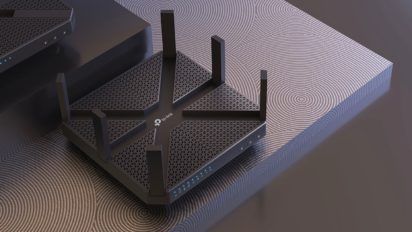Key findings
- Fiber and cable internet have the biggest gap between advertised and actual speeds – with most people getting, on average, about a third of the speeds they pay for
- Satellite and DSL internet, on the other hand, offer customers significantly lower speeds, but exceed the internet speed provided versus what is advertised
- Across the U.S., people are getting about 32% of the internet speed they pay for on average
It’s one of the most common frustrations in modern life: A Zoom meeting glitches or your Netflix show takes forever to load, and you can’t help but wonder, “Is this really the internet I’m paying so much for?”
In most cases, the answer is a resounding “no.” Our data shows that cable and fiber are by far the most common home internet connections in the U.S., but they’re also the most likely to under-deliver, with most people getting only a quarter of the speeds they’re paying for.
On the other end of the internet speed spectrum, satellite, DSL and fixed wireless providers advertise more modest speeds than cable and fiber, but they’re far more likely to actually reach them. In fact, our data shows that these connection types actually get you faster speeds than they advertise most of the time.
Our methodology
To determine the difference between advertised speeds and actual speeds Americans are getting, the Allconnect team evaluated internal data on actual speeds recorded between January 2022 and April 2023 and compared that to the advertised speeds purchased through Allconnect from each provider during the same period.
We also compared our results to data from the FCC’s Measuring Broadband America program, which gauges whether internet service providers are delivering on the internet speeds they promise. The 12th report was released in early January 2023, and used data collected in September and October 2021.
On average, Americans are only getting 32% of the speed they pay for
Overall, our data showed a significant gap between the internet speeds that providers are advertising and the speeds that users are actually experiencing. On average, home internet connections in the U.S. hover around 129 Mbps of download speed.
That’s a high number, to be sure — well above the 25 Mbps that the FCC defines as the minimum required to be considered broadband, and enough to stream Netflix in 4K on five screens at once and scroll through Facebook all at the same time. But it’s still significantly lower than internet service providers say you’ll get when you sign up. The download speed that’s advertised in an average American internet plan is 408 Mbps. However, ISPs only promise that you’ll get “up to” those speeds, so they’re not technically under-delivering.
Cable and fiber speeds are lower than advertised
The connection types that are most responsible for that gap are cable and fiber internet. By and large, these plans advertise extraordinary speeds. Right now, major internet service providers like Verizon and Xfinity claim their fiber plans reach “gig speed,” or download speeds of 1,000 Mbps.
While some customers might reach those heights, the reality is much closer to earth. On average, fiber internet plans advertise 414 Mbps of download speeds but only reach 100 Mbps in practice.
The gap is smaller with cable internet connections, which are still far more common in the U.S. than fiber. These plans have an advertised download speed of 404 Mbps on average, while in reality, it only delivers 168 Mbps.
DSL, satellite and fixed wireless connections are actually faster than advertised
While most Americans utilize a cable or fiber internet connection, these aren’t available in many rural parts of the country. In these areas, users typically rely on slower DSL, satellite or fixed wireless connections.
While these plans advertise slower speeds — typically around 20 Mbps — they’re far more likely to actually reach them. In fact, our data showed that the speeds DSL, satellite and fixed wireless users receive are actually higher than what they’re paying for.
Which internet providers delivered on their speed?
The chart below is taken from the FCC’s most recent Measuring Broadband America report. It shows how each internet service provider delivered on its advertised speeds. In the FCC’s analysis, each of the DSL providers delivered lower speeds than advertised, while cable and fiber providers were typically faster than promised.

Image credit: FCC’s Twelfth Measuring Broadband America – Fixed Broadband Report
Overall, Mediacom came out the best in the FCC’s analysis, providing download speeds nearly 30% higher than advertised. Cincinnati Bell DSL customers got the worst deal of the 12 providers the FCC tested, receiving less than 90% of the download speeds they’re paying for.
Why is Allconnect’s data different from the FCC’s?
Allconnect’s internal data shows that cable and fiber internet providers advertise faster speeds than they actually deliver, while the FCC’s report shows the opposite. Why the disparity?
To start, the FCC only evaluated 12 internet providers in their most recent report. These providers must actively choose to be a part of the Measuring Broadband America program, and some companies, like AT&T and HughesNet, did not participate this year. In addition, The Wall Street Journal reported that the FCC’s numbers are often severely inflated.
![]()
Companies wield tremendous influence over the study and often employ tactics to boost their scores, according to interviews with more than two dozen industry executives, engineers and government officials. As a result, the FCC’s report likely gives consumers an unreliable measure of internet providers’ performances by overstating speeds.
According to the report, the FCC lets ISPs know which customers are going to be a part of the speed tests, so they can provide faster speeds to those households to juice their numbers. They also rely on the companies to tell them what speed plan a user is signed up for. As former FCC chairman Tom Wheeler put it, “How can you go to the party who controls the information and say, ‘please give me information that may implicate you?’”
Allconnect’s analysis, on the other hand, relied on over 60,000 internet connections recorded over several months. While the FCC determined that, for most major providers, “measured download speeds were 100% or better than advertised speeds,” our results weren’t quite so rosy.
Why is my internet so slow?
Although your internet could be slow because of your provider, many internet speed issues don’t have anything to do with your provider’s network. You may need to add a Wi-Fi extender upstairs in your home to boost your signal or move your internet router to optimize your connection.
There’s also the possibility that your favorite activities require faster internet speeds than you have. If that’s the case, you may need to upgrade your internet plan to get more bandwidth, especially if your home has lots of connected devices.
For researchers and journalists
If you would like to know more about this topic, we can assist you. Our experts can help you dig deeper into the data.
Email our experts
Written by:
Joe SupanPrincipal Writer, Broadband Content
Joe is a senior writer for CNET covering home technology and broadband. Prior to joining CNET, Joe led MYMOVE’s moving coverage and reported on broadband policy, the digital divide, and privacy issues for the br…
Read more
-
Featured
![The best Wi-Fi routers of 2024]() The best Wi-Fi routers of 2024 Camryn Smith — 7 min read
The best Wi-Fi routers of 2024 Camryn Smith — 7 min read -
Featured
![18 tips to improve your internet connection and boost Wi-Fi signal]() 18 tips to improve your internet connection and boost Wi-Fi signal Camryn Smith — 9 min read
18 tips to improve your internet connection and boost Wi-Fi signal Camryn Smith — 9 min read -
Featured
![How much internet speed do I need?]() How much internet speed do I need? Joe Supan — 10 min read
How much internet speed do I need? Joe Supan — 10 min read
Latest
-
Wednesday, April 24, 2024
Why do you need an Optical Terminal Network?Taylor Gadsden — 2 min read
-
Tuesday, April 23, 2024
Worried about losing your TV signal? This is how to keep your satellite dish cleanDavid Anders — 6 min read
-
Tuesday, April 23, 2024
How to change your Wi-Fi network passwordCamryn Smith — 2 min read






